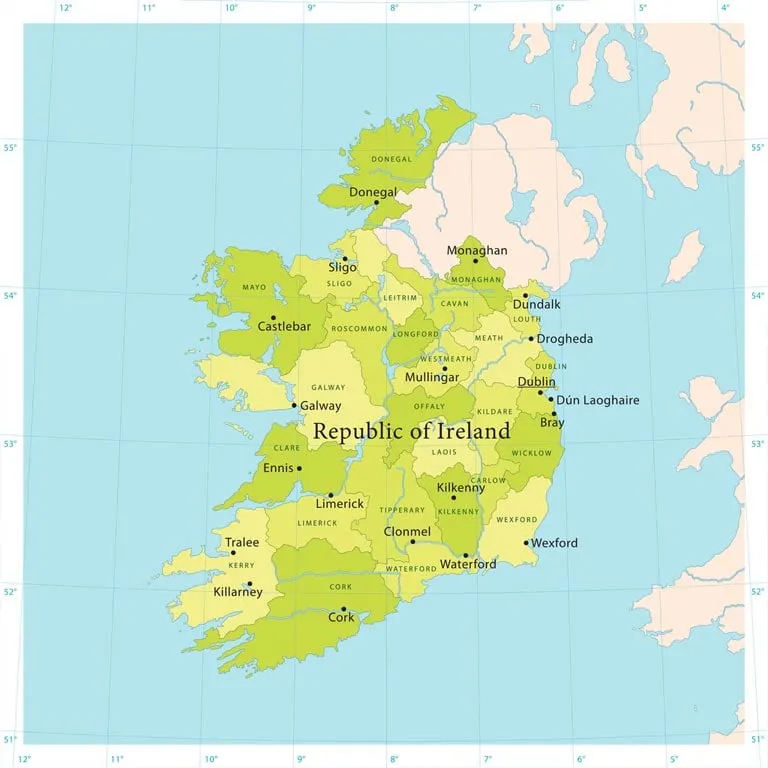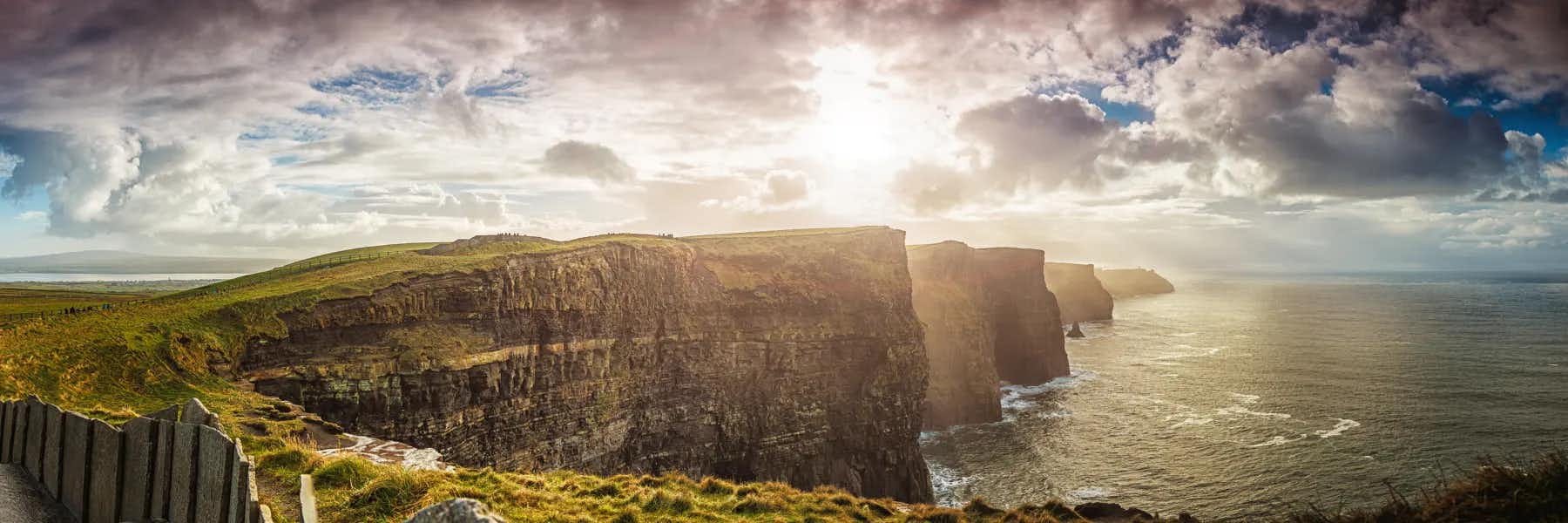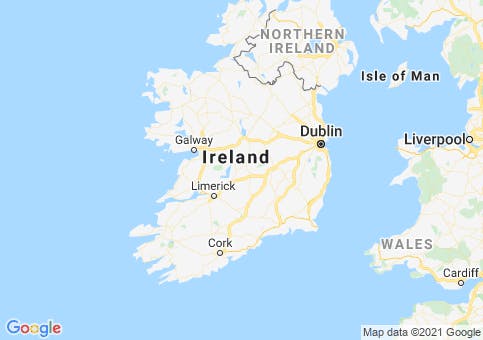Ireland is an island in northwestern Europe in the north Atlantic Ocean. It is separated from Great Britain to its east by the North Channel, the Irish Sea, and St George's Channel. Even if you have no familial ties to Ireland, you’ve likely heard plenty about what this small island nation has to offer: the stunning beauty of its dramatic coastlines, crumbling castles...a rich culture of music, dance, and literature...and warm, witty, friendly people.
The whole nation—but particularly the countryside—takes a small-town approach to life. Everyone in Ireland speaks English (even in the few Irish-speaking areas). The Irish are friendly, hospitable people. It may be a cliché, but it’s true. The literal translation of “hello” in Irish is “a hundred thousand welcomes to you.”
Living here, you don’t have to make a hard choice between seascapes and mountains, between tranquil lake lands or verdant river valleys. Ireland has them all.
In most towns and villages, you’re never too far from the ocean...from golden beaches swept clean by rolling Atlantic waves...the views of mysterious smaller islands shimmering offshore...and quaint harbor towns with their hand-painted shop fronts and color-washed cottages.
There’s never been a better time to consider Ireland as a retirement destination.
Quick Facts
Location: Western Europe, occupying five-sixths of the island of Ireland in the North Atlantic Ocean, west of Great Britain.
Area: 27,136 sq. miles
Population: 5,068,050 (July 2018 est.)
Capital: Dublin
Geography: Mostly flat to rolling interior plain surrounded by rugged hills and low mountains; sea cliffs on west coast.
Climate: Temperate maritime; modified by North Atlantic Current; mild winters, cool summers; consistently humid; overcast about half the time.
Government: Republic, parliamentary democracy.
Head of State: President Michael D. Higgins (since 11 November 2011)
Head of Government: Taoiseach (Prime Minister) Leo Varadkar (since 14 June 2017)
Language: English (official, the language generally used), Irish (Gaelic or Gaeilge) (official, spoken by approximately 39.8% of the population as of 2016; mainly spoken in areas along Ireland's western coast known as gaeltachtai, which are officially recognized regions where Irish is the predominant language)
Religion: Roman Catholic 78.3%, Church of Ireland 2.7%, other Christian 1.6%, Orthodox 1.3%, Muslim 1.3%, other 2.4%, none 9.8%, unspecified 2.6% (2016 est.)
An Overview of Ireland’s Regions
The Republic of Ireland has four provinces: Leinster, Munster, Connacht, and Ulster (it shares the latter with Northern Ireland). These are further divided into 26 counties.
• Leinster Province takes in the counties of Carlow, Dublin, Kildare, Kilkenny, Laois, Longford, Louth, Meath, Offaly, Westmeath, Wexford, and Wicklow.
• Munster Province is made up of Clare, Cork, Kerry, Limerick, Tipperary, and Waterford.
• Connacht Province is counties Galway, Leitrim, Mayo, Roscommon, and Sligo.
• Ulster Province includes the southern Irish counties of Cavan, Donegal, and Monaghan.
Although Ireland has long been popular with American visitors, many of its counties receive little attention. Counties like Kerry, Cork, and Galway arguably deserve all their accolades, but don’t just concentrate on the places that guidebooks give most weight to. We’ll be introducing you to some of our own favorite regions, but it’s always fun to make your own discoveries.To give you an idea of what the counties around Ireland have to offer, let’s take a look at each of them. We’ve listed the counties in alphabetical order.
Ireland’s Counties

Carlow
Ireland’s smallest inland county, Carlow isn’t on the tourist trail, but it’s a pretty county of rivers, pastureland, monastic ruins, and small towns backed by the Blackstairs Mountains (which are more hilly than mountainous). In other words, it’s typically Irish. I don’t know if you’d want to go hang-gliding off Mount Leinster, but there’s plenty of opportunity for golf, fishing, and gentle river cruising too.
County town: Carlow
Cavan
One of the Ulster counties, Cavan isn’t usually top of the list for those in search of romantic Ireland. It’s said, “Cavan is most famous because of Percy French’s song, Come back Paddy Reilly to Ballyjamesduff.” While it has an abundance of lakes, rivers, and forests, there are no real “must-see” attractions—not unless you’re a fisherman or a researcher of forgotten folk songs.County town: Cavan Town
Clare
Clare has lots going for it. A bastion of traditional foot-tapping music, its beautiful coastal scenery includes the mighty Cliffs of Moher. Inland, you can wander the “green roads” of the Burren—ancient drovers’ tracks leading across a rocky landscape where rare wildflowers bloom in spring. On the county’s eastern border is Lough Derg, a popular place in summer for watersports.
County town: Ennis.
Cork
Cork is Ireland’s largest county. The further westwards you travel from Cork City, Ireland’s second largest metropolis, the more gorgeous the seascapes become. West Cork is very popular with foreign home buyers, and deservedly so. Beaches, islands, harbors, great sailing, and the temperate Gulf Stream climate—definitely a county to consider.
County town: Cork City
Donegal
Donegal has the distinction of being Ireland’s northernmost county. Roads remain quiet and the scenery is fabulous: heather-clad mountains, glens, lakes, and a jagged coastline adorned with superb sandy beaches. Parts of its western coast are Gaeltacht areas where people still use Irish as their day-today language. In Irish, the county’s name is Dun na nGall, meaning “the fort of foreigners.” However, while foreigners are more than welcome, the weather isn’t as mild as the southern counties. Wintertime can be quite gray and gloomy—and it can feel very remote.
County town: Lifford
Dublin
Dublin, as everybody knows, is Ireland’s capital—and until 1994, it was a county too. Now called the “Dublin Region”, it’s divided into four administrative areas: Dublin City, Fingal, Dun Laoghaire/Rathdown, and South Dublin. Perhaps it’s because English rule lasted for 700 years, but some people find Dublin City lacking in charm. Energetic, lively, historic—certainly—and you can’t visit without spending at least a couple of days here. But as a place to live? Not if you’re looking to completely escape traffic congestion, high real estate prices, and crowds.
County town: Dublin
Galway
Galway is always a favorite with foreign home-buyers. It’s Ireland’s second largest county. Highlights include lively Galway City of the quirky alleys and little shops, Lough Corrib…the splendors of Connemara and the Twelve Bens mountain range…thatched and whitewashed cottages…sweet-faced Connemara ponies. Offshore are the three stony Aran Islands where the Irish language is still spoken.
County town: Galway City
Kerry
Known as “the Kingdom,” Kerry is a southwestern county and its stunning scenery has long attracted visitors. Just like in Victorian times, the major draw is still the wooded shores and glens of the Lakes of Killarney: island studded lakes guarded by the highest mountains in Ireland. But fabulous vistas aren’t the only arrow in Kerry’s quiver. There are many lovely coastal resorts, excellent fishing, a plethora of golf courses, the deserted Blasket and Skellig Islands and enough ancient monuments to make any historian drool.
County town: Tralee
Kildare
Kildare is an inland county bordering Dublin. Its lush green meadows and limestone plains have helped to make it classic horse-breeding country. This is where you’ll find the National Stud and many thoroughbred racehorses are bred, trained, and also raced around the Curragh, a grassy plain that stretches unfenced for over 5,000 acres. Plus there are some top class golf courses including the K Club, a venue for the European Open. However, Kildare is a very popular commuter county and prices tend to be higher.
County town: Naas
Kilkenny
Dotted with ancient abbeys and monasteries, Kilkenny in Ireland’s southeast is one of the prettiest and most historically fascinating of Ireland’s inland counties. Hunting, angling, shooting, golf—and the country’s best-preserved medieval town, Kilkenny City. Bubbling with creativity, villages along the county’s Nore river valley are also noted centers for arts and crafts—you can follow a Crafts Trail from Kilkenny, “the Marble City.”
County town: Kilkenny City
Laois
Although it has over 1,000 historical sites and the “heritage town” of Abbeyleix, Laois isn’t too well-known to visitors. If you want to get completely away from it all, this county, deep in the Irish midlands could be worth considering. However, although the valleys and waterfalls of the Slieve Bloom hills are scenic enough, this is not the Wild West. Much of the countryside is flat, boggy, and rather monotonous looking.
County town: Portlaoise.
Leitrim
Low-key Leitrim has the status of a western seaboard county, but in reality, it only has two miles of coastline. Ireland’s most sparsely populated county, it’s noted for lakes, rivers, and angling. In recent years, there’s been a lot of investment and Carrick-on-Shannon has become a lively marina town. The county’s Glencar Waterfall inspired W.B. Yeats to pen a poem called The Stolen Child. Listen hard and you may just hear the fairy folk sending out seductive whisperings to leave the world of weeping behind. “Come away, O human child, to the waters and the wild…”
County town: Carrick-on-Shannon
Limerick
Spread out around the Shannon estuary, Limerick is Ireland’s Jekyll and Hyde county. On the one hand, the county is richly endowed with mythological sites and gorgeous green countryside, where hunters ride to hounds. There are myriad quiet villages—thatched-roof Adare probably does deserve its title as Ireland’s prettiest village. And on the other hand there’s Limerick City. Although it’s nothing like as grimly horrible as portrayed in Angela’s Ashes, you’d have to be possessed of a very thick pair of rose-tinted glasses to fall in love with it.
County town: Limerick City
Longford
County Longford is a quiet and fairly pastoral midlands county, where you can still find reasonable value property, but don’t expect too much in the way of scenic wows. That said, some villages are attractive—pick of the crop is Ardagh.
County town: Longford Town
Louth
County Louth’s inland areas are more rewarding than its less scenic stretch of coastline. Monasterboice has a round tower and high Celtic crosses, Mellifont has its medieval abbey, and the Cooley Peninsula is as wild as anywhere. Louth was also the site of the Battle of the Boyne, which effectively ousted the Stuarts from the throne of England. But Dundalk is a heart sinking sprawl of a town. And though it’s certainly historic, Drogheda doesn’t feel much better.
County town: Dundalk
Mayo
Peppered with hundreds of little islands, the western seaboard county of Mayo shares similar seascapes and mountain scenery to Galway. Visible from most of the county, conical-shaped Croagh Patrick is a pilgrimage mountain which thousands of people climb every year. Legend tells that it was from here that St. Patrick cast the snakes out of Ireland. For house-buyers, the eastern part of the county is far cheaper than the coast.
County town: Castlebar
Meath
Once the seat of the High Kings of Ireland, County Meath has a long tradition of agriculture, six miles of coastline, the Grand National horse race at Fairyhouse, and some of Ireland’s most important archeological sites: Newgrange, Knowth, and Dowth. But, being so close to Dublin, this is commuterland. Prices here can be high.
County town: Navan
Monaghan
Lakes, market towns, and small “drumlin” hills shaped like upturned eggboxes. One of the border counties, Monaghan is about as far removed from the tourist trail as you can get. Few visitors find their way here, yet there’s several megalithic sites and Carrickmacross has a long history of lacemaking. The poet Patrick Kavanagh was a native of the village of Iniskeen, but the overall impression of many of its towns and villages is of dreariness.
County town: Monaghan Town.
Offaly
A midlands county, much of the Offaly countryside is brown bogland—an extraordinary landscape, but unrelenting on the eye. But it’s not all bog—the county has a share in the valley glens and heather-clad hills of the Slieve Bloom Mountains. Birr is a neat Georgian town whose castle has beautiful gardens and also a giant telescope. Beside the Shannon is Clonmacnoise of the round towers and high Celtic crosses—one of the great monastic centers of Ireland’s “Golden Age.” And, if you do have a thing about peat bogs, Bord Na Móna (the Irish Peat Board) run tours through the Blackwater Bog on the Clonmacnoise and West Offaly railway.
County town: Tullamore.
Roscommon
Go on guidebook recommendations and you’ll find absolutely no reason to come to Roscommon . It’s an inland county, mostly pancake-flat, and the only real “visitor attraction” is a Famine Museum at Strokestown. Of course, the guidebook writers don’t know about the bluebell woods…the family of badgers slinking along the lane at twilight…the holy well with a cure for backache…the Keadue festival where people still dance on doors…St. Barry’s stone boat…or the legends of Queen Maeve whose court (and personal entrance to the Otherworld) was at Rathcroghan.
County town: Roscommon Town.
Sligo
Bounded on its western edge by the Atlantic Ocean, Sligo is a northwestern county made famous by the poet W.B. Yeats as The Land of Heart’s Desire. This is one of the places where legendary Ireland comes to life, where every landmark seems imbued with stories of the distant Celtic past.
County town: Sligo Town.
Tipperary
Ireland’s largest inland county, Tipperary can’t give you a coastline, but its Galtee Mountain landscapes of high hills and verdant valleys are pleasing on the eye. Although it’s famous within Ireland for hunting and hurling, most foreign travelers come here to marvel at the Rock of Cashel, rising like an Irish Acropolis from the plains of the Golden Vale farmlands. The county is divided into two administrative areas—the North Riding and South Riding.
County towns: Nenagh (North Riding) and Clonmel (South Riding).
Waterford
In southeast Ireland, Waterford is a coastal county known in tourist brochures as “the Crystal County.” Waterford Crystal is a world-famous product and although it’s not produced here anymore, the Waterford Crystal visitor center is still a major stop for coach parties who then charge straight on west into County Cork. Few visitors go walking in the Nire Valley, the Comeragh Hills, or explore ancient abbeys and holy wells in the county’s seaside villages. That’s a shame—Waterford is an attractive county, which is maybe why International Living chose to make it their headquarters.
County town: Waterford City
Westmeath
Deep in the Irish Midlands, Westmeath is another of the country’s lesser-known counties, a place of small towns, rolling countryside, and centurie-sold abbeys. It calls itself “the Land of Lakes and Legends.” Set on Lough Derravaragh, the most famous legend is that of the Children of Lir, whose stepmother turned them into swans.
County town: Mullingar.
Wexford
In Ireland’s south-east corner, County Wexford has a fascinating Viking past, the country’s best sunshine records, miles of golden sandy beaches, pretty rural villages, thatched cottages aplenty, and Wexford Town, home to Europe’s quirkiest opera festival. This is your best bet for finding a home for a reasonable price on the east coast.
County town: Wexford Town
Wicklow
Wicklow is known as “the Garden of Ireland.” The coast, the Wicklow Hills, and ancient places such as Glendalough make the county a very desirable location—but it’s located next-door to Dublin. The commutability factor translates into high property values— outside of the capital, it’s now the most expensive county in which to buy a home.
County town: Wicklow Town










